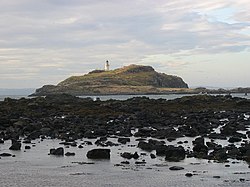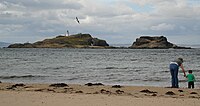Fidra: Difference between revisions
No edit summary |
No edit summary |
||
| Line 12: | Line 12: | ||
|population=0 | |population=0 | ||
}} | }} | ||
'''Fidra''' is an uninhabited island in the [[Firth of Forth]], 2½ miles north-west of [[North Berwick]], in [[East Lothian]]. | '''Fidra''' is an uninhabited island in the [[Firth of Forth]], 2½ miles north-west of [[North Berwick]], in [[East Lothian]]. It forms part of the parish of [[Dirleton]]. | ||
The island’s name was formerly written "Fidrey"<ref name=history>{{brithist|43439|Faifley – Fifeshire; A Topographical Description of Scotland by Lewis, Samuel (1846)}}</ref> or " Fetheray".<ref>Skene, W. F. (November 1862) "Of the early Frisian Settlements in Scotland". Antiquaries of Scotland. '''4''' Part 1.</ref> The name is Norse: ‘’Fiðrey’’, meaning "feather island",<ref>Ryder, N.L. [http://www.envarch.net/publications/circaea/6.2/circaea(6.2-1990).pdf "Displacement of bone waste by seagulls"] (pdf) ''Circaea'': The Bulletin of the Association for Environmental Archaeology. '''6''' No. 2 (1990) University of York. p. 85. Retrieved 19 September 2010.</ref> no doubt referring to the large number of bird feathers found there. | The island’s name was formerly written "Fidrey"<ref name=history>{{brithist|43439|Faifley – Fifeshire; A Topographical Description of Scotland by Lewis, Samuel (1846)}}</ref> or " Fetheray".<ref>Skene, W. F. (November 1862) "Of the early Frisian Settlements in Scotland". Antiquaries of Scotland. '''4''' Part 1.</ref> The name is Norse: ‘’Fiðrey’’, meaning "feather island",<ref>Ryder, N.L. [http://www.envarch.net/publications/circaea/6.2/circaea(6.2-1990).pdf "Displacement of bone waste by seagulls"] (pdf) ''Circaea'': The Bulletin of the Association for Environmental Archaeology. '''6''' No. 2 (1990) University of York. p. 85. Retrieved 19 September 2010.</ref> no doubt referring to the large number of bird feathers found there. | ||
Latest revision as of 13:56, 11 May 2022
| Fidra | |
 Fidra | |
|---|---|
| Location | |
| Location: | 56°4’20"N, 2°47’3"W |
| Grid reference: | NT512868 |
| Area: | 25 acres |
| Highest point: | 66 feet |
| Data | |
| Population: | 0 |
Fidra is an uninhabited island in the Firth of Forth, 2½ miles north-west of North Berwick, in East Lothian. It forms part of the parish of Dirleton.
The island’s name was formerly written "Fidrey"[1] or " Fetheray".[2] The name is Norse: ‘’Fiðrey’’, meaning "feather island",[3] no doubt referring to the large number of bird feathers found there.
Geography
Like the other islands near North Berwick, Fidra is the result of volcanic activity around 335 million years ago. Fidra consists of three sections; a hill at one end with the lighthouse on it; a low lying section in the middle, effectively an isthmus; and a rocky stack at the other end.
History

Like the nearby Bass Rock, Fidra has a substantial seabird population, and is now an RSPB reserve. The village of Gullane lies to the south-west, and the nature reserve of Yellowcraigs and village of Dirleton, to which parish Fidra belongs, are to the south. Remotely-operated cameras on the island send live pictures to the watching visitors at the Scottish Seabird Centre in North Berwick.[4]
Upon the island are ruins of an old chapel, or lazaretto for the sick, which was dedicated in 1165 to St Nicholas. In the 12th century, the island formed part of the barony of Dirleton, which was granted to the Anglo-Norman John de Vaux by King David I. The de Vaux family built a stronghold, known as Tarbet Castle, on the island, but in 1220, William de Vaux gifted Fidra to the monks of Dryburgh Abbey, in the Borders. His successor built Dirleton Castle, on the mainland, as a replacement dwelling.[5]

Lighthouse
The lighthouse, which was built in 1885 and automated in 1970, can be accessed via a primitive jetty on the east of the island.[6] The light flashes 4 times every 30 seconds.[7]
Cultural references
Robert Louis Stevenson often visited the beaches at the area known today as Yellowcraigs and it is said that he based his map of Treasure Island on the shape of Fidra. (This claim is also made about the island of Unst in Shetland.) He also mentioned Fidra in his novel Catriona.[8]
Fidra Books is a publishing house, named after the island, and which uses Fidra's outline as part of its logo.[9]
The prog rock band Marillion also briefly mention Fidra in the song, Warm Wet Circles, which contains the line "She nervously undressed in the dancing beams of the Fidra Lighthouse",[10] the coast nearby apparently being a well-known courting spot.[10]
Footnotes
- ↑ Faifley – Fifeshire; A Topographical Description of Scotland by Lewis, Samuel (1846)
- ↑ Skene, W. F. (November 1862) "Of the early Frisian Settlements in Scotland". Antiquaries of Scotland. 4 Part 1.
- ↑ Ryder, N.L. "Displacement of bone waste by seagulls" (pdf) Circaea: The Bulletin of the Association for Environmental Archaeology. 6 No. 2 (1990) University of York. p. 85. Retrieved 19 September 2010.
- ↑ Fidra Web Cam - Scottish Seabird Centre
- ↑ Tabraham, Chris (2007) Dirleton Castle 2nd edition. Historic Scotland. ISBN 978-1-904966-41-8 pp.21-22
- ↑ Haswell-Smith, Hamish (2004). The Scottish Islands. Edinburgh: Canongate. ISBN 1841954543.
- ↑ Reeds Small Craft Almanac, London, Adlard Coles Nautical, 2007
- ↑ "Fidra". Gazetteer for Scotland. http://www.scottish-places.info/features/featurefirst1599.html. Retrieved 2008-06-18.
- ↑ "Fidra Books". http://www.fidrabooks.co.uk/. Retrieved 2008-06-18.
- ↑ 10.0 10.1 Schipper, Jeroen (ed.) (1992-1997). "What is the Fidra Lighthouse?". Marillion Frequently Asked Questions. http://www.faqs.org/faqs/music/marillion-faq/part1/section-36.html. Retrieved 2008-06-18.
Outside links
- Fidra Web Cam - Scottish Seabird Centre
- Images of Fidra
- Fidra light
| The islands of the Firth of Forth | |||
|---|---|---|---|
| West Lothian | Midlothian | East Lothian | Fife |
| Inchgarvie | Cramond Island • Inchmickery • Cow and Calves | Bass Rock • Craigleith • Eyebroughy • Fidra • The Lamb | Inchcolm • Oxcars • Isle of May • Inchkeith |